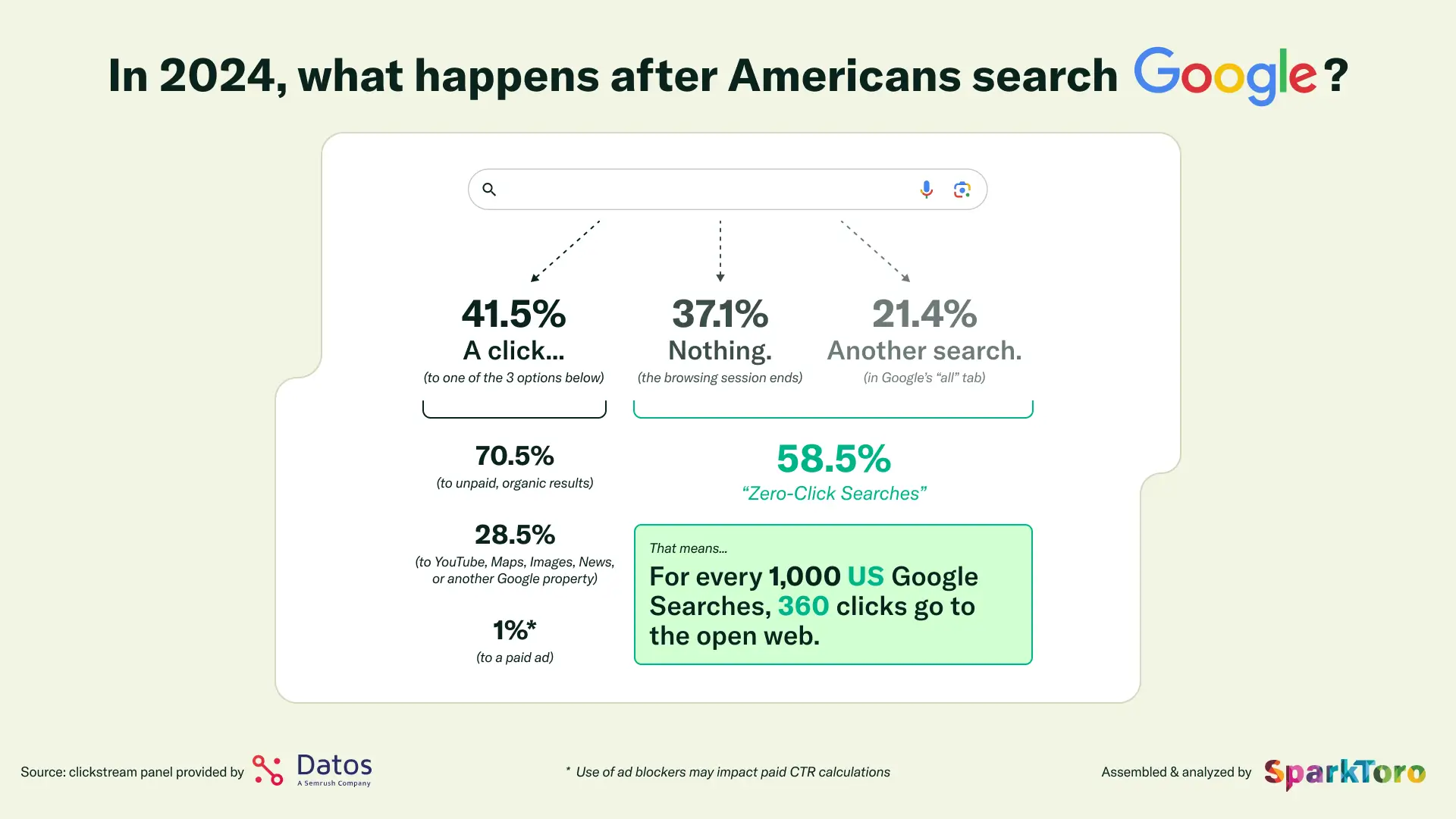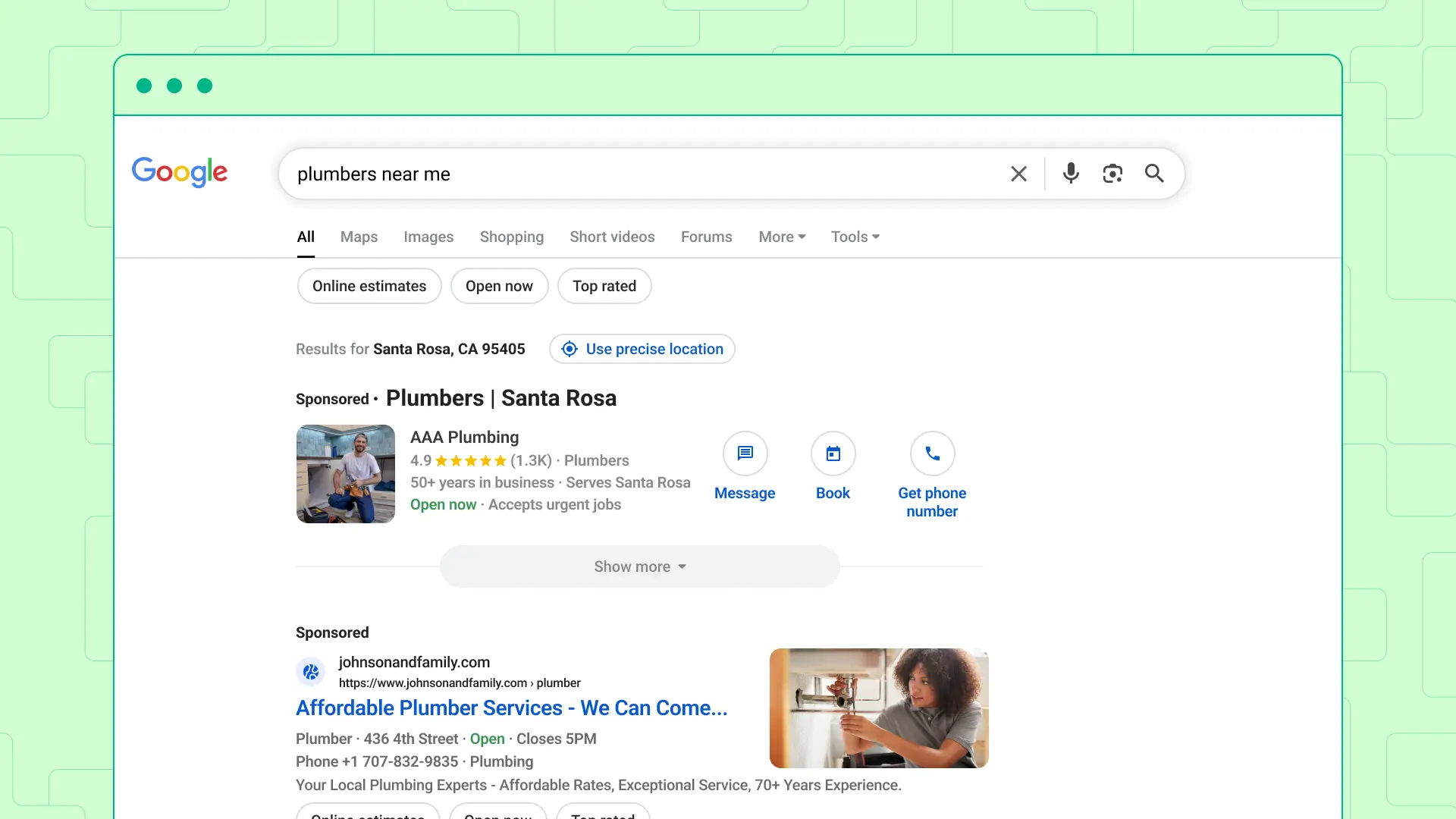Don’t have time to read? Watch or listen to the AI video overview below!
Here’s the uncomfortable truth: the organic search game has changed forever. Across B2C industries, organic traffic is trending down, not because your content suddenly got worse, but because the search experience is answering more questions before anyone needs your site. Pretending you can crank out a few more listicles and “get back to 2022 traffic” is magical thinking. The goal now is to have fewer, more qualified visits that turn into revenue, while treating search as just one touch in a complex, multi-channel buyer journey.
What Actually Changed
First, zero-click is the default, not the exception. Recent clickstream data from SparkToro shows that out of every 1,000 U.S. Google searches, only about 360 result in a click to the open web. And most Google searches go to — big surprise — Google properties, not your website. That’s not a seasonal dip. That’s the SERP doing the job for the user. When the answer sits in a unit above your listing, you can “rank” and still see fewer visits.

Second, AI Overviews have become the new front door. They don’t always appear, and their behavior keeps shifting, but when they do show, they frequently satisfy intent without a click. It’s worth noting that before Google launched AI Overviews, featured snippets accomplished the same thing, though they often provided less information than Overviews do. BrightEdge’s long-running tracking suggests the overlap between Overview citations and traditional rankings is rising overall, though it varies by industry and still isn’t one-to-one. Translation: you can’t assume that earning a top 10 ranking automatically earns you a citation inside the AI box. You have to build for both.
Third, forums got promoted. Since Google’s “hidden gems” push in late 2023, Reddit and niche community threads have crowded “which/why/how” queries in product research and troubleshooting. Those lived experiences and edge cases that people love in forums are now front and center. Brand content that reads like a brochure can’t compete.
Fourth, local layouts compress organic. For service businesses in healthcare, home services, financial and professional services, Local Services Ads and the map pack sit above traditional listings. Many users never scroll past call buttons and direction taps. That’s not “bad SEO.” That’s a different conversion surface.

Finally, Google raised the bar on content quality. Google’s March 2024 update integrated helpful-content ideas into core ranking and introduced policies against scaled junk, site-reputation abuse, and expired-domain schemes. A lot of traffic loss in 2024–2025 came from those changes shaking out what gets rewarded. If parts of your site rode borrowed authority or thin content, you probably felt it.
So What KPIs Do We Optimise For Now?
Your first step is to stop obsessing over raw organic sessions. Traffic volume was always a vanity metric, if we’re to be honest. If zero-click is rising and AI keeps answering, then a pure “more visits” target will lead you to chase impressions that don’t move the business and targets that you can’t hit. The better questions to ask are:
- Are we covering the buyer’s real questions across discovery, research, comparison, and conversion?
- Are our search efforts creating qualified leads, a robust pipeline, and revenue growth?
- Did lower traffic actually correlate with worse outcomes, or did our mix shift to higher-intent visits with better conversion rates?
- Are we connecting what started in search to what closed on the phone, in the contact center, or business locations?
That last one matters more than people admit. In categories like home services, healthcare, insurance, and financial services, high-intent buyers still pick up the phone. According to recent Invoca research, 67% of consumers called when making a high-stakes purchase.
If your reporting ends at “session” or even “form fill,” you’re undercounting the outcomes search is driving. Organic matters, but now it’s just one part of a connected journey that also encompasses generative answers, paid media, social media, your website, and phone conversations.
How To Adapt: Use AI To Find The Leaks, Name The Thief, And Ship Countermoves
Let’s keep this practical. You don’t need a new 80-page strategy doc. You need two sprints and a dashboard that leadership can actually read.
Sprint 1: Find and size the leak
Pull 24 months of Google Search Console data and cluster queries by intent: informational, commercial research, local, and troubleshooting. An LLM can handle the clustering and flag the “flat position, falling clicks” segments. When rankings hold steady but clicks drop, the layout changes. That’s not a content gap; it’s a SERP real-estate problem shaped by AI Overviews, forums, ads, maps, or video.
Sample and screenshot each representative SERP on mobile and desktop. Annotate what’s above the fold. Is there an AI Overview? Are you cited? How many forum results? Are LSAs sitting on top? Keep a weekly sample for a month so you can show stakeholders the pattern instead of arguing about it. Better yet, use an SEO tool like Ahrefs to track your average ranking over time, and tracks your placement in AI overviews, LSAs, and more and create your dashboards from that data.
Sprint 2: Ship the right countermove
Now that you know what’s stealing your clicks, respond in kind.
If AI Overviews dominate
- Add a crisp, 40–80 word answer block on the appropriate pages and back them with first-party evidence: your tests, pricing methodology, device-specific steps.
- Mark up FAQs. Create scannable headings to make your page easy to cite.
- Track whether you’re being cited and whether those citations drive follow-up clicks or branded queries. BrightEdge’s tracking shows overlap with organic has improved overall, but it’s inconsistent by industry, so don’t assume. Build for both ranking and citation.
If forums crowd you out
- Publish experience-rich guides: parts lists, tools, risks, edge cases, photos, and short clips from your own testing.
- Where it makes sense, host moderated Q&A or expert replies on your domain and link them contextually from the guide.
- Target the long-tail questions forums that dominate and answer them better, with proof.
If LSAs/Maps choke the fold
- Treat Local Services Ads and Google Business Profile as core inventory. Get eligibility, reviews, categories, services, and appointment links right.
- Follow up with new customers and request reviews to bolster your GBP presence.
- Track calls, messages, and direction taps alongside website clicks so you see the real conversion surface for “near me” intent. Google’s own guidance is blunt: LSAs appear above both organic and PPC listings. Plan accordingly.
If quality updates hit you
- Audit for the March 2024 tripwires: scaled thin content, site-reputation abuse, expired-domain band-aids. Consolidate, delete, or rebuild.
- Strengthen E-E-A-T signals on “Your Money or Your Life” (YMYL) topics with real experts and reviewable sources. Submit for reconsideration only after you’ve actually fixed the problem.
Build The Dashboard That Ends The “Traffic” Debate
Replace the vanity graph with an outcome-focused view. Your KPI set should show:
- Intent coverage: share of impressions where you appear in top 10 and where you’re cited in AI Overviews.
- Click resilience: query clusters where average position is flat but CTR fell, flagged by the dominant SERP element (Overview, forum, LSA/Maps, video).
- Outcomes: leads, pipeline, revenue, and phone-driven conversions attributed back to the originating intent and surface, not just the last web click.
This is where connecting conversation data pays off. If a homeowner sees an AI Overview, taps a call button in LSAs, books a job, and the deal closes after a call, your organic program did its job even if the web session never happened. The only way to prove this is to integrate search data with paid media, site analytics, and call outcomes so you can track the entire journey and optimise the stages that actually move revenue.
Industry-Specific Tactics You Can Put To Work Now
- Automotive teams should lean into model- and trim-specific research with video embeds and comparison tables, then localise offers so shoppers can call or book a test drive directly from surfaces that sit above organic links.
- Healthcare and professional services should prioritise “treatment near me” and appointment flows within GBP, while incorporating clinician bios and citations on condition pages to meet YMYL expectations.
- Insurance and financial services should refocus on providing decision support through calculators and scenario-based comparisons, rather than relying on definitional terms.
- Telecom should publish device-specific fix trees with micro-videos to earn citations and create a reason to click when users need the full steps.
The Mindset Shift is On
Organic search data still matters. It tells you where buyers are and what they’re asking. But it isn’t the be-all-end-all, and it never was. The job now is to optimise the entire buying journey for outcomes: more customers, more revenue, lower CPA, higher ROAS. If the path to that outcome includes an AI Overview mention, a forum detour, a map tap, and a phone call, that’s not failure. That’s how buyers behave in 2025. Build for it, measure it, and win on purpose.
Get an Invoca demo to see how you can fully connect the buyer journey, go beyond traffic and drive results that matter.

